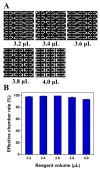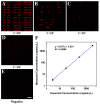A Self-Priming Microfluidic Chip with Cushion Chambers for Easy Digital PCR
- PMID: 34069758
- PMCID: PMC8155915
- DOI: 10.3390/bios11050158
A Self-Priming Microfluidic Chip with Cushion Chambers for Easy Digital PCR
Abstract
A polydimethylsiloxane (PDMS)-based self-priming microfluidic chip with cushion chambers is presented in this study for robust and easy-operation digital polymerase chain reaction (dPCR). The chip has only one inlet and can partition samples autonomously through negative pressure, provided by a de-gassed PDMS layer with a multi-level vertical branching microchannel design. Meanwhile, cushion chambers make the chip capable of very robust use for sample partitioning. Finally, the proposed microfluidic chip showed excellent performance in the absolute quantification of a target gene by performing quantitative detection of a 10-fold serial dilution DNA template. Owing to its characteristics of easy operation, low cost, and high robustness, the proposed dPCR chip is expected to further promote the extensive application of digital PCR, especially in resource-limited settings.
Keywords: cushion chambers; digital PCR; microfluidic chip; self-priming.
Conflict of interest statement
The authors declare no conflict of interest.
Figures






Similar articles
-
A self-digitization chip integrated with hydration layer for low-cost and robust digital PCR.Anal Chim Acta. 2019 May 9;1055:65-73. doi: 10.1016/j.aca.2018.12.029. Epub 2018 Dec 21. Anal Chim Acta. 2019. PMID: 30782371
-
A nanoliter self-priming compartmentalization chip for point-of-care digital PCR analysis.Biomed Microdevices. 2015;17(3):9970. Biomed Microdevices. 2015. PMID: 26029750
-
A nanoliter self-priming compartmentalization chip for point-of-care digital PCR analysis.Biomed Microdevices. 2015;17(3):64. doi: 10.1007/s10544-015-9970-9. Biomed Microdevices. 2015. PMID: 26022215
-
Integration of isothermal amplification methods in microfluidic devices: Recent advances.Biosens Bioelectron. 2017 Apr 15;90:174-186. doi: 10.1016/j.bios.2016.11.045. Epub 2016 Nov 19. Biosens Bioelectron. 2017. PMID: 27888686 Review.
-
Microfluidic Devices for Forensic DNA Analysis: A Review.Biosensors (Basel). 2016 Aug 5;6(3):41. doi: 10.3390/bios6030041. Biosensors (Basel). 2016. PMID: 27527231 Free PMC article. Review.
Cited by
-
Recent Advances in Digital Biosensing Technology.Biosensors (Basel). 2022 Aug 23;12(9):673. doi: 10.3390/bios12090673. Biosensors (Basel). 2022. PMID: 36140058 Free PMC article. Review.
-
Advances in genotypic antimicrobialresistance testing: a comprehensive review.Sci China Life Sci. 2025 Jan;68(1):130-143. doi: 10.1007/s11427-023-2570-4. Epub 2024 Sep 18. Sci China Life Sci. 2025. PMID: 39300049 Review.
-
Device Processing Challenges for Miniaturized Sensing Systems Targeting Biological Fluids.Biomed Mater Devices. 2022 Sep 22:1-17. doi: 10.1007/s44174-022-00034-z. Online ahead of print. Biomed Mater Devices. 2022. PMID: 40479273 Free PMC article. Review.
-
Conductive Silver/Carbon Fiber Films for Rapid Detection of Human Coronavirus.Polymers (Basel). 2022 May 12;14(10):1983. doi: 10.3390/polym14101983. Polymers (Basel). 2022. PMID: 35631866 Free PMC article.
-
Virtual Multiplexing Chamber-Based Digital PCR for Camel Milk Authentication Applications.Micromachines (Basel). 2023 Aug 17;14(8):1619. doi: 10.3390/mi14081619. Micromachines (Basel). 2023. PMID: 37630155 Free PMC article.
References
-
- Vendrell J.A., Mazieres J., Senal R., Rouquette I., Quantin X., Pujol J.L., Roch B., Bouidioua A., Godreuil S., Coyaud E., et al. Ultra-sensitive EGFR (T790M) detection as an independent prognostic marker for lung cancer patients harboring EGFR (del19) mutations and treated with first-generation TKIs. Clin. Cancer Res. 2019;25:4280–4289. doi: 10.1158/1078-0432.CCR-18-2683. - DOI - PubMed
-
- Laurent-Puig P., Pekin D., Normand C., Kotsopoulos S.K., Nizard P., Perez-Toralla K., Rowell R., Olson J., Srinivasan P., Le Corre D., et al. Clinical relevance of KRAS-mutated subclones detected with picodroplet digital PCR in advanced colorectal cancer treated with anti-EGFR therapy. Clin. Cancer Res. 2015;21:1087–1097. doi: 10.1158/1078-0432.CCR-14-0983. - DOI - PubMed
MeSH terms
Substances
Grants and funding
LinkOut - more resources
Full Text Sources

